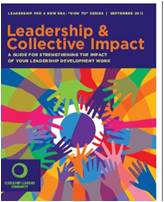 Last week, the Leadership Learning Community sponsored a beautifully-facilitated gathering in Boston to celebrate the launch of its new publication Leadership & Collective Impact. The room of about 25 people included network weavers, organizational consultants, funders, writers, community organizers – all working in some way to advance collective impact and network approaches to social change.
Last week, the Leadership Learning Community sponsored a beautifully-facilitated gathering in Boston to celebrate the launch of its new publication Leadership & Collective Impact. The room of about 25 people included network weavers, organizational consultants, funders, writers, community organizers – all working in some way to advance collective impact and network approaches to social change.
Here are some of the strategic questions that these leaders who are on the ground implementing these approaches are wrestling with:
- Given how critical relationship-building is in networks, how do we track the connections made and the value eventually created out of them? David Crowley, of Social Capital Inc., said they have a practice of logging information and anecdotes about exchanges in a Google doc. Some spoke of how conventional ways of evaluating success fall short when looking for network effects. Audrey Jordan of Boston Rising said “We don’t want to be captive to conventional measures that don’t capture what we know matters and is happening.”
- How do we capture “unexpected value” that emerges from networks? For example, the results or lessons learned that emerge from this work that are not what we set out to do or the results that hop across network boundaries to ripple into other networks. One piece of this is capturing stories. Here is a tool that was recommended for capturing stories in a searchable way: http://www.zahmoo.com.
- If trusting relationships are critical to a diverse group collaborating to achieve big results, how can we cultivate authentic relationships and meaningful connections in how we design meetings and social change processes? What does it mean to shift from treating strengthened relationships as a by-product of collective action to viewing strengthened relationships and trust as a prerequisite for collective action? Audrey Jordan said “Transforming a community only happens when the relationships between various stakeholders are transformed from business-as-usual to a common vision with collective action around shared goals of mutual prosperity.”
- How can we create “disruptive experiences” that get participants out of their daily work and roles in ways that disrupt and open perspectives and enable deep, authentic connections? For example, the Barr Fellows Network that took non-profit leaders on a sabbatical, with a joint trip to the Global South (e.g., Haiti, Brazil, South Africa, Zimbabwe.) How can we create these experiences in less expensive ways, closer to home, e.g., learning journeys?
- Networks are inherently fluid and evolve. How can we fund in ways that are responsive to the evolving needs and priorities of networks? For example, the RE-AMP network in the Midwest includes funders and NGO’s who jointly develop strategic priorities via work groups. NGO’s can apply for grants from a Strategic Action Fund, which are granted in line with the priorities. What would it look like to have funds readily available as emergent ideas and projects bubble up from collaborators in networks?
- How do you reconcile these two orientations to change:
- Groups need a measurable goal and a way to measure progress and do action-learning as they pursue the goal.
- When we build strong webs of relationship and collaboration, ideas and motivation for joint action will emerge, generating outcomes we cannot foresee (and may foreclose if we focus too much on pre-determined goals.)
